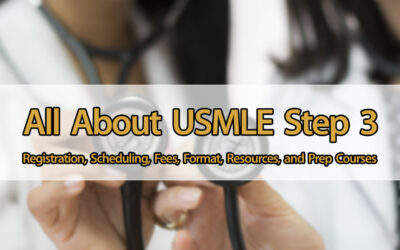The United States Medical Licensing Examination (USMLE) Step 3 is the final milestone for those aiming to practice medicine in the United States. Computer-based Case Simulations (CCS) are a particularly unique and challenging section among its many components. In this part of the exam, candidates must demonstrate their skills and knowledge in a dynamic, clinical scenario-like environment. This blog post aims to provide extensive insights, tips, and study strategies to master the CCS portion of the USMLE Step 3.
Understanding the USMLE Step 3 CCS
The CCS component of the USMLE Step 3 stands out as an innovative and challenging portion of the exam. Often described as a videogame rendition of a patient encounter, it offers an engaging twist to the conventional testing format. Unlike other segments, it’s an interactive platform where candidates are tasked with the dynamic management of unfolding patient scenarios. They must navigate a maze of situations as they progress, making critical decisions in real-time.
The primary interface of this segment is designed to simulate real-world clinical settings. Candidates interact with the software through free-text entries, inputting patient orders that influence the case’s trajectory. To further mirror the actual patient care experience, intuitive buttons, and checkboxes allow candidates to advance the timeline, shift the patient’s location, revisit prior information, and continually receive feedback about the patient’s ongoing status.
Its holistic evaluation approach makes the CCS an actual test of medical mettle. It doesn’t just focus on a single medical domain; it gauges a candidate’s prowess in diagnosing and treating conditions spanning multiple specialties. This comprehensive nature ensures that only well-rounded clinicians pass muster. On the intense second day of the Step 3 exam, candidates are thrust into a whirlwind of 13 distinct CCS cases. Each case has challenges and a time limit ranging from 10 to 20 minutes. The variability in time allocation correlates directly with the intricacy of each scenario. Hence, aspirants need robust clinical insight and mastery over the software to sail through this segment, ensuring every move they make is clinically sound and time-efficient.
5 Fundamental Tips for Success
Tackling the CCS portion of the USMLE Step 3 might seem formidable, but the right strategies can pave the way for success. As you embark on this journey, consider these five essential strategies to guide your preparation. From software familiarity to leveraging established resources, these foundational tips aim to streamline your study process and elevate your test performance. Dive in to harness the power of structured guidance and actionable insights.
- Familiarize Yourself with the Primum CCS Software
The first crucial step is to become familiar with the software used for the CCS portion of the USMLE Step 3. Understanding how to navigate the interface is essential as it’s the primary method of interacting with the test format. The USMLE website provides practice materials that include a detailed breakdown of the test format and an animated demonstration of the Primum CCS software. Engaging with this software early in your preparation journey can set the foundation for a seamless user experience during the test.
Moreover, by being well-acquainted with the software’s functionality, you avoid technical snags on exam day, ensuring your focus remains undivided. Allocate time specifically to understand every tool and feature within this software. Your aim should be to attain comfort where the software becomes an extension of your thought process rather than a challenge to grapple with.
- Practice the 6 USMLE CCS Cases
The USMLE Step 3 CCS presents six cases. Practicing these cases can help you detect patterns in how the test is designed, avoiding common pitfalls and minimizing unnecessary back-and-forth on Test Day. These cases, essentially real-life simulations, are crafted to test your capability to apply theoretical knowledge in practical situations. Tackling them repeatedly can significantly boost your adaptability and confidence.
Furthermore, collaborating with peers to solve these cases can open up diverse perspectives and strategies. Engaging in group discussions after practicing can reveal alternative solutions and insights. This collective knowledge-sharing is an excellent way to fortify your understanding and anticipate a variety of case presentations.
- Use Third-Party Software
While the USMLE website is a credible source of information on the CCS software, exploring third-party options could be beneficial. Different software may offer slightly different features and help you understand how the exam operates. Diversifying your preparation tools can offer a more rounded perspective, allowing you to adapt to different question styles and presentation formats.
Conduct thorough research to identify third-party software that aligns with your learning style and preferences. By immersing yourself in multiple platforms, you gain a broader understanding of exam dynamics and prepare yourself for unexpected software nuances or shifts in question patterns.
- Master the Boards Step 3
This standard text used for CCS prep on the USMLE Step 3 is an invaluable resource. The book provides CCS tips and hints and can be a universal source to prepare for the exam. It is available in print and digital formats to suit your preferences1. This reference material is curated by experts with years of experience and understanding of the USMLE landscape.
The insights offered in this book are not merely theoretical. They often derive from real-life scenarios and challenges faced by students in previous years. Engaging with this material enriches your core knowledge and sharpens your strategy, enabling you to manage time, prioritize tasks, and make decisions with enhanced clarity during the exam.
- Consistent Practice
Consistent practice is vital to succeeding in the CCS portion of the USMLE Step 3. Completing every UWorld practice case can help you understand the fine points of the scoring system and master the software. Dedication and regularity in practice sessions play a pivotal role in building muscle memory, so actions on test day become more reflexive than reactive.
With time, as you steadily engage with various cases, patterns begin to emerge. Recognizing these patterns, understanding the scoring metrics, and adjusting your approach can significantly elevate your performance. As the saying goes, “Practice makes perfect.” In the context of USMLE Step 3, consistent practice doesn’t just lead to perfection; it paves the way for excellence.
Additional Important Tips
In addition to these tips, there are some essential things to keep in mind:
- The second day of Step 3 will feature 13 computer-based case simulations (CCS), each with a maximum allotted time of 10-20 minutes. The CCS cases assess your abilities to diagnose and treat conditions across all specialties.
- Completing the CCS practice cases teaches a crucial lesson regarding Step 3: it’s a test on how the USMLE thinks you should manage a condition, not how you might do it in your hospital. Understanding this perspective is vital for success on the exam.
- Having a system or outline to approach each case can ensure broad categories of assessments are included, like labs or procedures. An example outline could be: History, Physical, Orders (Labs, Imaging, Consults, Procedure, Counseling, Inpatient orders), Advancement of care/Reassess.
- Learning to manage treatment for CCS practice cases involves determining what bundles of orders you should send each patient, thinking about what information you need to diagnose and treat the patient, and starting the appropriate treatment as soon as you know the diagnosis.
The Importance of Practice
The Computer-based Case Simulations (CCS) component of the United States Medical Licensing Examination (USMLE) Step 3 can present a unique challenge even for seasoned medical students and professionals. The test is structured like a video game version of a patient encounter, demanding a completely different set of skills and approaches than conventional question-answer-based tests. This is why practice is so crucial.
The first step in acing the CCS component is to become familiar with the Primum CCS software, which is used to structure the test. By familiarizing yourself with the software and structure of the test, you can ensure you know the test format on the exam day. It is recommended to watch the demonstration of the software provided on the USMLE website and practice the six USMLE® CCS cases provided for test preparation.
The very nature of the CCS component lends itself to collaborative study. By practicing cases with fellow students, you can learn from their test-taking strengths and weaknesses and benefit from collective knowledge. Consider using third-party CCS software, which can provide a slightly different set of features and a more interactive experience.
In conclusion, practice is critical to mastering the USMLE Step 3 CCS. The more you practice, the more adept you’ll become at recognizing patterns in the test, avoiding common pitfalls, and efficiently navigating the software. With ample practice, you can turn this unique exam part into an opportunity to boost your score.
A Closer Look at the CCS Cases
On the second day of Step 3, you’ll encounter 13 computer-based case simulations (CCS), each with a maximum allotted time of 10-20 minutes. The cases are designed to assess your abilities to diagnose and treat conditions across a wide range of specialties, meaning more is needed to rely on your residency experience to get you through.
The CCS cases can vary greatly. Some may present textbook examples of common diseases, while others might be subtler. Some may align with your specialty of training, while others could pertain to fields you have not worked in since your third year of medical school. Regardless of the case details, the basic organizational needs will be the same for every case. Using an outline can help you stay organized and prevent missteps. For example, a basic overview may include sections for History, Physical Orders (Labs, Imaging, Consults, Procedure, Counseling, Inpatient orders), and Advancement of care/Reassess.
Notably, the CCS cases are designed to test how the USMLE expects you to manage a condition, not necessarily how you might do so in your actual hospital. This is where practicing the cases is handy, as it helps you understand and align with USMLE’s expectations.
How to Study Effectively for CCS Cases: Create a Study Plan
To succeed in the CCS portion of the USMLE Step 3, you need to figure out how to use the CCS portion of the USMLE Step 3 is a critical component of the examination and is considered a “video game version” of a patient encounter. The CCS, or Computer-based Case Simulations, requires free-text entry of patient orders as the primary means for interacting with the format, along with buttons and checkboxes for advancing the clock, changing the patient’s location, reviewing previously displayed information, and obtaining updates on the patient.
Having a systematic study plan can be very beneficial. This could involve doing a case per day, aligning the cases with your studies (for example, if you are studying for the cardiology portion of the written exam, you could also work on the cardiology CCS cases), or setting aside 7-10 days after the first day of Step 3 to focus on CCS preparation.
Outline for CCS Cases
To make sure to include broad categories of assessments, it’s helpful to have an outline for each case. A well-structured outline serves as a roadmap, guiding you through the case without overlooking essential aspects. A simple, generally applicable summary might consist of a history, physical, orders (labs, imaging, consults, procedures, counseling, inpatient orders), and the advancement of care/reassess. Such an outline can streamline your thought process, ensuring a comprehensive approach to each case and minimizing the chances of missing out on critical components.
While the same cases that appear on each individual’s Step 3 exam can vary, the importance of an all-encompassing preparation must be stressed more. The unpredictability of the cases emphasizes the need for comprehensive coverage in your studies. While the USMLE provides some sample cases for study purposes, the organization does not disclose the specific cases that would appear in the actual exam. Hence, the golden ticket lies in familiarizing oneself with the broad spectrum of potential clinical scenarios. Coupled with rigorous practice using the case simulation software, this will make you adept, allowing you to leverage the software’s features and face any case confidently.
Understand the Scope of the Exam
Before crafting your study plan, it’s essential to understand the scope of the CCS portion of the USMLE Step 3. It consists of 13 computer-based case simulations, each with a maximum allotted 10-20 minutes. These cases assess your ability to diagnose and treat conditions across all specialties. By grasping the exam’s breadth, you’ll be in a better position to tailor your study plan according to the intricacies of the exam. Familiarizing yourself with the specific case types and their respective durations can significantly bolster your time management skills, ensuring you are neither rushed nor unprepared for any scenario.
Assess Your Schedule and Study Style
Everyone has a different study style and schedule. Some people can study for long hours, while others prefer shorter, more frequent study sessions. Some people study best in the early morning, while others prefer late at night. Determine what works best for you. It’s also crucial to consider your current schedule. If you’re working or have other responsibilities, you’ll need to find ways to integrate study time into your simple plan. Recognizing and harmonizing your peak productivity hours with your obligations can lead to an optimized study routine, ensuring you are always at your best during your preparation.
Determine the Time Frame
The total time you dedicate to studying for the Step 3 CCS will depend on several factors, including your familiarity with the material, how recently you’ve encountered the topics in your coursework or rotations, and how much time you can dedicate to studying each day. As a rule of thumb, you might want to consider giving yourself an extra 7-10 days after the first day of Step 3 to study for the CCS portion. This buffer will offer ample opportunities to revisit challenging topics, undertake intensive practice sessions, and relax to recharge.
Break Down Your Study Material
The USMLE Step 3 CCS covers a wide range of specialties. Break down the material into manageable sections that you can tackle individually. This could be by the system (e.g., cardiology, pulmonology, gastroenterology, etc.) or by type of condition (e.g., infectious diseases, chronic diseases, emergency conditions, etc.). By segmenting your content, you ensure a structured approach to your preparation, minimizing the chances of overlooking crucial topics. The segment-based study can also boost retention rates and allows for more focused revisions, ensuring a holistic grasp of each specialty.
Make Use of Available Resources
You can use several resources to prepare for the CCS portion of the USMLE Step 3. For instance, the USMLE provides practice materials and a demonstration of the Primum CCS software on its website. Kaplan Test Prep suggests watching the march and practicing the six USMLE® CCS cases provided. Using third-party software such as UWorld to practice cases is also recommended, as it helps you understand the fine points of the scoring system and get a feel for the exam format. Numerous online forums and communities exist where fellow aspirants and previous test-takers discuss best practices and share valuable insights. Leveraging these discussions can provide alternative strategies and broaden your understanding of the examination’s nuances.
Draft a Study Schedule
Once you’ve broken down your material and have a time frame, you can start drafting your study schedule. A good strategy is to do a case per day, ensuring that you work through each CCS practice module and gradually build up the efficiency you need. Try to line up cases with your studies. For instance, if you’re studying for the cardiology portion of the written exam, you could also work on the cardiology CCS cases to further reinforce the material. This integrated approach will help better retention and hone your application skills. Periodic assessments or mock tests can be added to your schedule, giving you a clear idea of your progress and areas needing improvement.
Incorporate Regular Review and Practice
It’s essential to regularly review material you’ve already covered to ensure it stays fresh in your mind. Regular practice is also crucial in preparing for the CCS portion of the USMLE Step 3. You can use the Primum CCS software and third-party platforms such as UWorld for practice. Practicing with a fellow student can also be beneficial as it allows you to learn from each other’s strengths and weaknesses. This mutual learning experience can also help simulate a more realistic test environment, pushing both of you to elevate your performance. Over time, these sessions can lead to the development of effective strategies and tricks tailored specifically to your learning style, ensuring optimal performance during the actual exam.
Create an Outline for Every Case
Having a consistent system for every case can be helpful. Regardless of the case details, basic organizational needs will be the same for every case. This can include aspects like history, physical orders (labs, imaging, consults, procedure, counseling, inpatient orders), and advancement of care/reassessment. An outline can help prevent missing broad categories of assessments, like labs or procedures, which could cost you points.
An outline serves as a guiding compass through each case’s intricate details. This checklist ensures no vital steps are missed. Given the time constraints of the exam, a structured approach aids in managing time efficiently while providing a systematic approach. By familiarizing yourself with this outline, you integrate it into your examination strategy, enhancing your chances of success.
Remember, the key to doing well on the CCS portion of the USMLE Step 3 is practice and understanding how the USMLE wants you to manage conditions. So make sure your study plan includes the following:
- Ample time for practice cases.
- Understanding the software.
- Learning the necessary medical knowledge.
Handling Patient Treatment
First, you should determine which bundles of orders you should send to every patient. This is an especially critical aspect if you’re already an intern, as it should mirror the admission orders you submit regularly. This might need more consideration for those who still need to start residency. For example, in an emergency department scenario, you should request pulse oximetry, which isn’t included in the vitals for some cases. Other standard orders include cardiac monitoring and oxygen immediately upon a patient’s arrival. You’ll likely want a basic set of labs on most patients, such as CBC, BMP, LFTs, coagulation panels, and urinalysis. Familiarizing yourself with standard bundles of orders will save you valuable time during the test, as you won’t have to think about what to order in each case.
Second, consider what additional information you need to diagnose and treat the patient. Once you have the basic knowledge and labs, feel what imaging or diagnostic studies you need next. You can lose points for not ordering the relevant studies. Still, you can also lose points for unnecessarily invasive tests (e.g., going straight to cardiac catheterization before ordering an EKG). Depending on the chief complaint, an EKG, x-ray, or ultrasound can be a good starting point.
Third, start the appropriate treatment without delay as soon as you have a clear idea of the diagnosis. This includes ordering any medication you might need, including symptom management like pain control. Call for any consults you might need (though they won’t offer any recommendations), and order whatever procedure the patient might need (for example, cholecystectomy for cholecystitis). This also includes moving the patient to the most appropriate location. If the patient needs surgery, admit them to the inpatient floor1.
Conclusion: Pass Your Step 3 CCS Cases with High Performance
To truly excel and achieve high performance on the Step 3 CCS, it’s not just about rote memorization or isolated practice. It’s about adopting a holistic understanding of the patient care paradigm envisioned by the USMLE. Delving deep into pattern recognition based on how test-makers formulate questions and scenarios is vital. Moreover, frequent feedback loops, revisiting challenging areas, and maintaining consistency in preparation can significantly enhance performance. By integrating these elements with unwavering dedication, you set yourself on a path to pass and excel in the CCS component, thereby bolstering your overall exam score.
Frequently Asked Questions
What is the USMLE Step 3 CCS?
The USMLE Step 3 CCS, or Computer-based Case Simulations, is a part of the Step 3 exam. It’s essentially a virtual patient encounter where the primary means of interaction is through the free-text entry of patient orders. Buttons and checkboxes are used to advance the clock, change the patient’s location, review previously displayed information, and obtain updates on the patient.
How many CCS cases are there in Step 3?
The CCS portion of the USMLE Step 3 presents 13 cases on the second day of the exam, with each case having a maximum allotted time of 10-20 minutes.
How does the USMLE Step 3 CCS work?
The CCS works like a video game version of a patient encounter. The test-taker enters patient orders in free-text format, uses buttons and checkboxes to advance the clock, change the patient’s location, review information, and get patient updates. The cases assess the test-taker’s ability to diagnose and treat conditions across all specialties.
How can I prepare for the USMLE Step 3 CCS?
There are several strategies for preparing for the CCS:
- Familiarize yourself with the Primum CCS software by watching the demonstration on the USMLE website.
- Practice the 6 USMLE® CCS cases available for practice.
- Practice cases with fellow students to learn from each other’s strengths and weaknesses.
- Consider using 3rd party CCS software to get a feel for different features and operations.
- Use the CCS tips and hints in the book “Master the Boards Step 3″.
- Complete all the UWorld practice cases to understand the scoring system’s fine points and get practice using the software.
- Follow a consistent outline or strategy for every chance to ensure you don’t miss any broad categories of assessments.
- Develop bundles of orders you send to every patient to save time and ensure you don’t forget anything.
- Start appropriate treatment as soon as you know the diagnosis.




